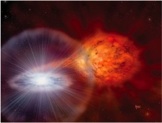
 Links |
Public /
VacationProjects2014–15These vacation projects will be offered centrally by Monash over the period November 2014–February 2015. If you are interested in any of these projects please apply here Title: Exploring the Extreme Transient Sky Abstract: The European Space Agency’s (ESA) XMM-Newton satellite routinely detects the brightest and faintest of X-ray sources, including accreting black holes and neutron stars, active galactic nuclei, and even distant galaxy clusters. The X-ray detectors feature large effective area in the 0.2–10 keV energy range, permitting sensitive observations for faint sources at good spatial and spectral resolution. XMM-Newton has been observing the X-ray sky for over 11 years, and has accumulated an extensive database of observations covering a substantial fraction of the sky. The July 2013 release of the 3rd XMM-Newton Serendipitous Source Catalogue, the largest X-ray source catalogue ever produced, includes detections of 372,728 unique individual sources from 7,427 observations. A substantial fraction of these sources are "transients", for which the nature and characteristics are unknown. This project will involve developing strategies to select sources from the catalog and, using archived observations in other wavelengths, to deduce their nature. Work will be carried out in collaboration with researchers at the Centre for All-Sky Astrophysics based at the University of Sydney. The transient fraction of the catalog has barely been explored so far, so there is a good chance of discovery of new sources with unusual properties. Prompt transient followup strategies may also be adapted for use in the Variable and Slow Transients (VAST) program on the Australian Square Kilometre Array Pathfinder (ASKAP), currently under construction. Project Start Date: default Title: X-ray bursts from rapidly-rotating neutron stars Abstract: A small fraction of neutron stars in our Galaxy have a binary companion, that can donate gas onto the compact object. This gas contributes substantial angular momentum to the neutron star, and so this accretion process will tend to increase the spin rate of the neutron star, up to many hundreds of rotations per second. Millisecond pulsars are X-ray bright neutron stars which show periodic intensity variations at the presumed spin period, and approximately 15 of these systems are known. Millisecond pulsars also exhibit X-ray bursts, which are caused by thermonuclear burning of the accreted material. These bursts last 10-100 seconds, and recur every few hours or longer, depending upon the fuel accretion rate. Since millisecond pulsars are a high observational priority (primarily due to their rarity), observations during their infrequent transient outbursts have a good chance of catching X-ray bursts. The objective of this project is to match the observed properties of bursts in recently-discovered systems with the behaviour predicted by numerical ignition models. This matching has the prospect of measuring the system distance, fuel composition, and even the neutron star mass and radius, measurements that are challenging otherwise. The project will take advantage of existing numerical burst ignition code, as well as extensive X-ray observational data from NASA and ESA satellite-based observatories. Project Start Date: default Title: Clouds across a neutron star: dipping in low-mass X-ray binaries Abstract: Some neutron stars are born in binary star systems, and if the stellar companion later expands during its evolution it may start to transfer mass to the neutron star. In that case, the gas flows onto the neutron star through an accretion disk, and is heated to tens of millions of degrees in the process. The intense X-rays from the neutron star can be interrupted intermittently by gaseous material at the outer edge of the accretion disk; this "dipping" is mainly known from high-inclination systems (i.e. where the disk is viewed almost-edge on). Recently an example of intermittent dipping has been discovered, in the system Aquila X-1 (Galloway 2012, ATel #4014). This system is not known to be high inclination, so the exact cause of the dips is unclear. The goal of this project is to investigate the dynamics of the accretion disk via the dipping phenomenon. The student will be tasked with searching for additional examples of intermittent dips in a large sample of X-ray data collected by NASA's Rossi X-ray Timing Explorer satellite. Comparison of the measured inclination of this and any additional system shown to exhibit intermittent dips, to that of the systems that show no dips, will provide new measurements of how wide an angle the disk-edge gas can span. Project Start Date: default back to the home page |